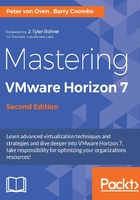
View Persona Management
Let's start with a little bit about the background and history behind View Persona Management. View Persona Management was originally a technology product called Virtual Profiles and was acquired by VMware from RTO Software in 2010. It was first introduced with View 5.0, and it allows you to configure user profiles so that they dynamically synchronize with a remote profile repository that is located on a file server in the data center. Its purpose is to manage user profiles within a virtualized desktop environment.
Note
More information about the acquisition can be found at http://www.vmware.com/content/dam/digitalmarketing/vmware/en/pdf/vmware-rto-acquisition-faq.pdf .
VMware View Persona Management was first introduced with View 5.0, and it allows you to configure user profiles that dynamically synchronize with a remote profile repository located on a file server in the data center.
Why do we need to manage user profiles differently in VDI?
In a VDI solution, one of the key benefits is the way the virtual desktop is either built on demand or delivered from a pool of prebuilt, floating desktops and then delivered back to the user. The typical deployment model is the floating model, which basically means that the user doesn't actually own their own desktop.
When they log in, they could have any desktop delivered to them from a pool of available virtual desktop machines. This means that the virtual desktop that is delivered would not be personalized to that particular user. It would just be a standard vanilla build of the operating system and applications.
This is where View Persona Management comes into play and delivers the user's profile to the floating virtual desktop they have been assigned, effectively making it theirs.
When we talk about the desktop being built on demand, we are referring to how a desktop is put together from several different components. The desktop can be broken down into three components: the operating system, applications, and the user's personalization or profile, essentially the bit that makes the desktop yours. As a user logs on, all these pieces come together to deliver the end user desktop experience. In this particular example, we are talking about the user's profile.
This is shown in the following diagram:

In this section, we will have a detailed look at View Persona Management to manage the user profile element and the key benefits it delivers. A deep dive into a technical overview and details on how to configure View Persona Management can be found in Online Chapter, Managing User Profiles in Virtual Desktop Infrastructure, available at https://www.packtpub.com/sites/default/files/downloads/5657_ManagingUserEnvironmentsinVirtualDesktopInfrastructure.pdf.
The benefits of Persona Management
At high levels, View Persona Management provides the following features:
- Fast loading of user personalization settings, with just-in-time retrieval of user profile data
- Little or no infrastructure required-just a file share or the use of an existing folder redirection structure
- Profile consistency maintains personalization between sessions
- Efficient architecture with no dependency on Windows roaming user profiles
- Multiplatform support for Windows XP, Windows Vista, Windows 7, Windows 8.x, and Windows 10
In addition to the listed features, View Persona Management also helps reduce virtual desktop TCO by enabling the move to a stateless virtual desktop environment. In some deployments, users were placed in dedicated pools solely to retain their profile settings, which added to the cost and complexity in management. On the subject of cost, as Persona Management is an integrated part of Horizon View, you don't necessarily need to purchase additional third-party products, unless you need additional functionality above and beyond the basics.
While on the subject of management, there are no additional components to set up or install, as everything is driven by Active Directory Group Policy; in terms of scalability, again, as there are no infrastructure overheads such as databases, scalability does not cause any problems.